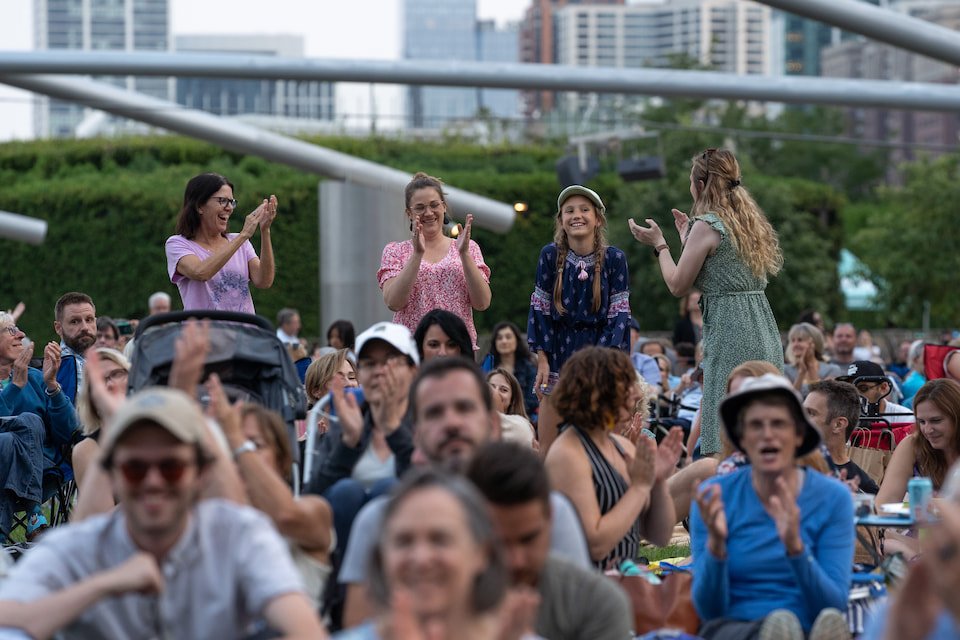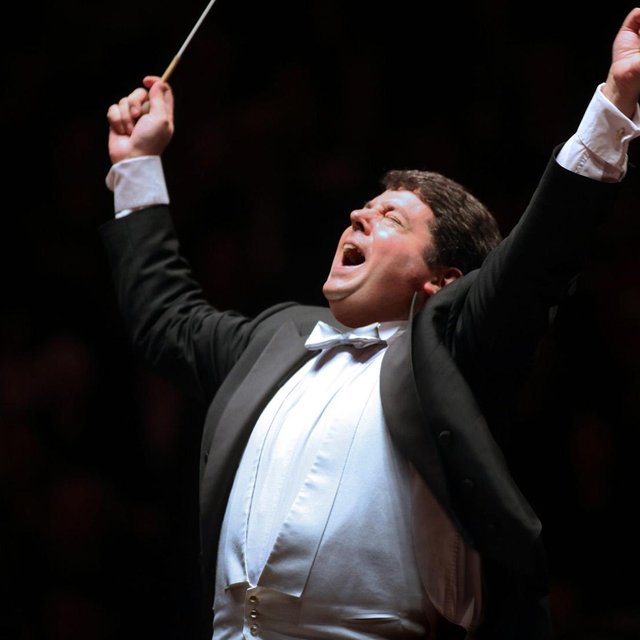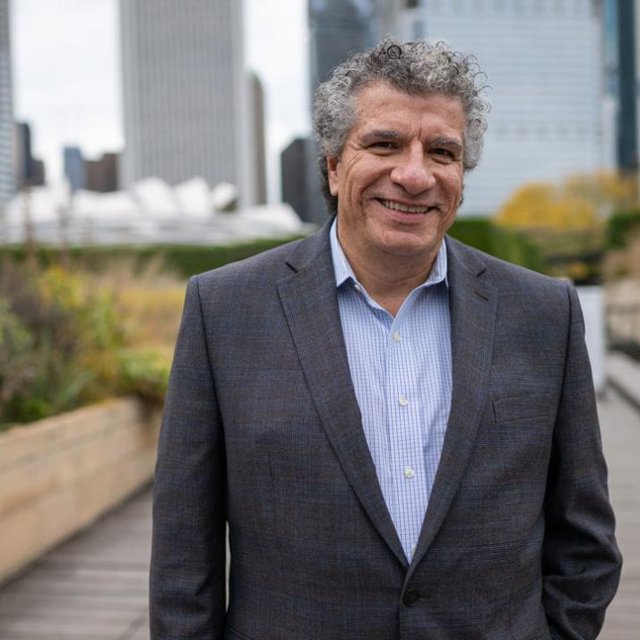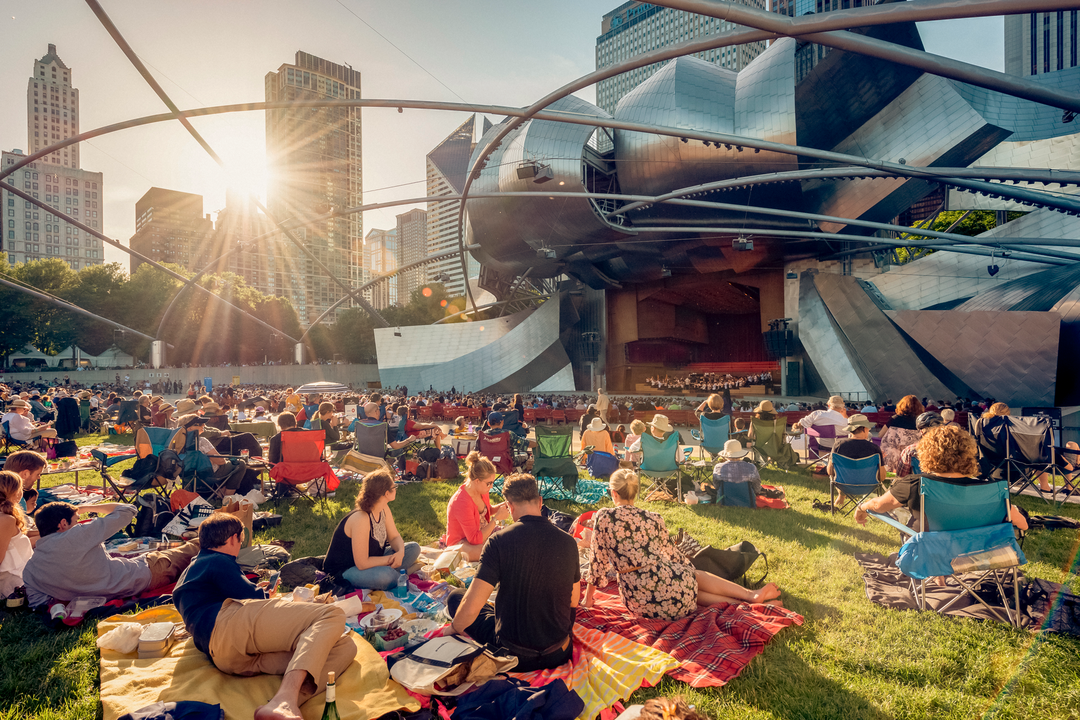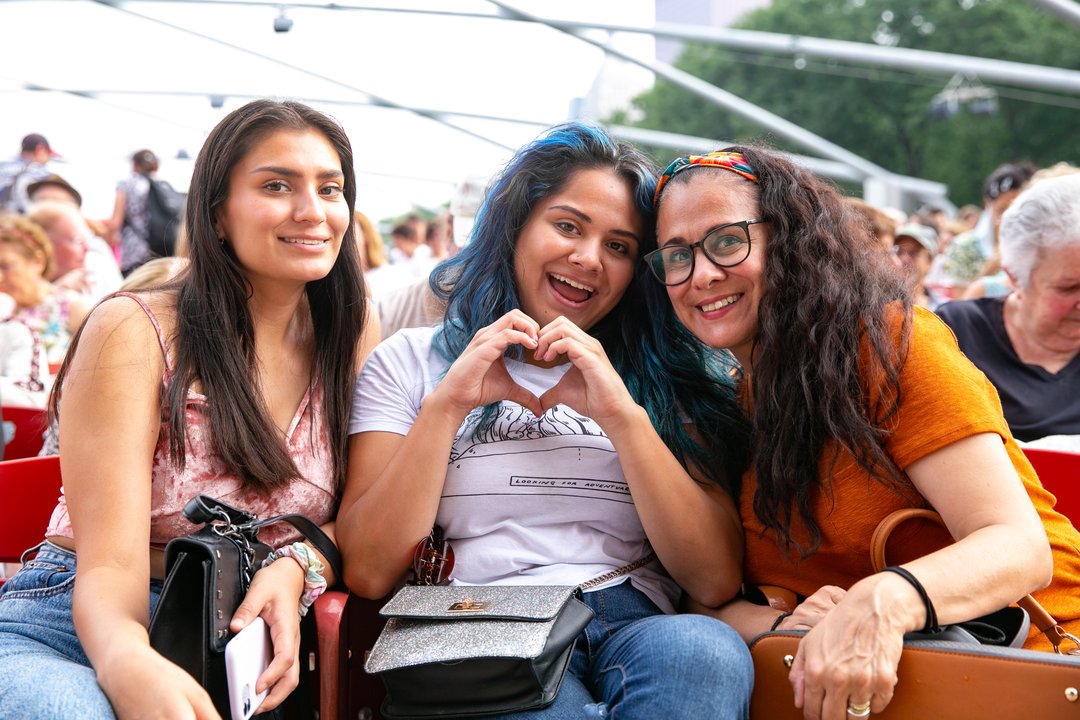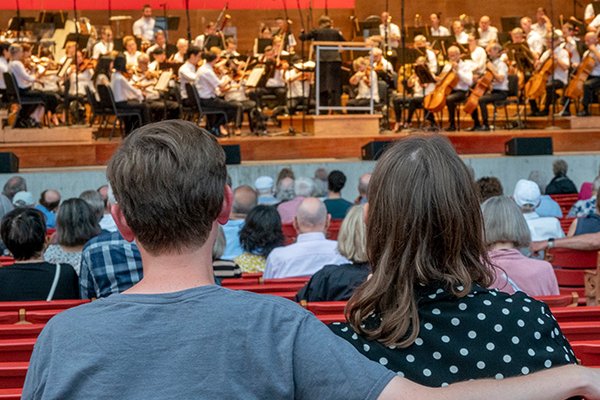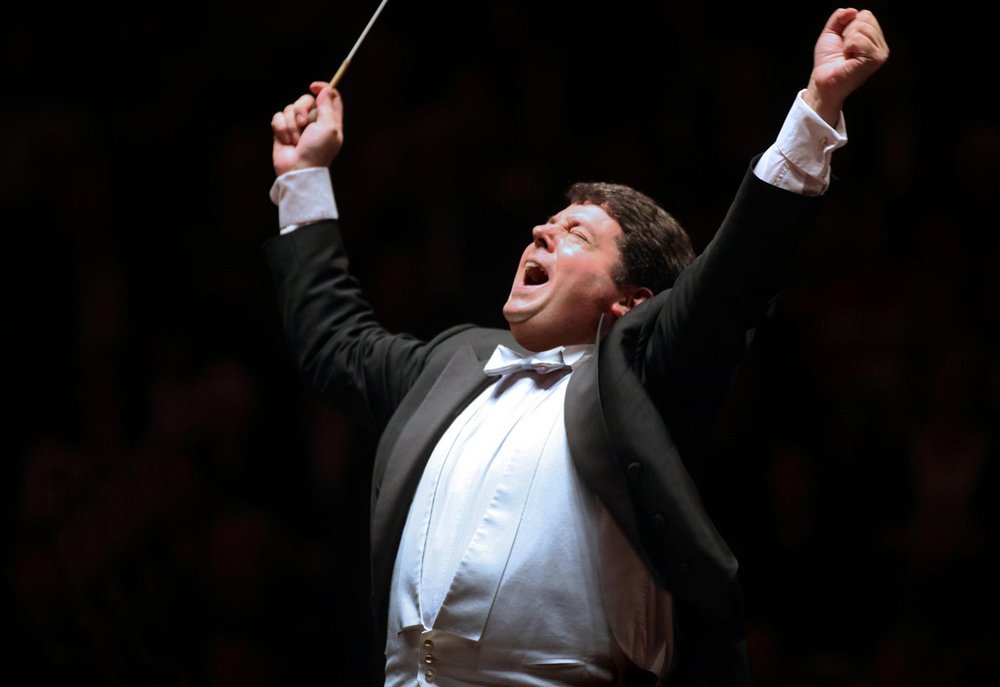
Rhapsody in Blue
Program
Gabriela Lena Frank Three Latin American Dances (20 mins)
Introduction: Jungle Jaunt
Highland Harawi
The Mestizo Waltz
George Gershwin Rhapsody in Blue (16 mins)
Manuel de Falla Suites from The Three-Cornered Hat (24 mins)
Introduction - Afternoon
Dance of the Miller’s Wife (Fandango)
The Corregidor The Miller’s Wife
The Grapes
The Neighbors Dance (Seguidillas)
The Miller’s Dance (Farruca)
Final Dance (Jota)
Featuring
Program Notes
Gabriela Lena Frank (b. 1972)
Three Latin American Dances (2003)
Scored for: three flutes including piccolo, three oboes including English Horn, three clarinets including bass clarinet, three bassoons, four French horns, three trumpets, three trombones, timpani, percussion, harp, piano, and strings
Performance time: 20 minutes
First Grant Park Orchestra performance
Named one of the “35 Most Significant Women Composers in History” by the Washington Post in 2017, Gabriela Lena Frank currently serves as composer-in-residence with the Philadelphia Orchestra. She was born in Berkley, California, to a mother of Peruvian/Chinese ancestry and a father of Lithuanian/Jewish descent. Throughout her career, her multicultural heritage has been central to her compositional identity, her voice an amalgam of her lived experiences as a multiethnic Latina and the paradoxes inherent in that reality. She writes that her early days were “filled with Oriental stir-fry cuisine, Andean nursery songs, and frequent visits from our New York-bred Jewish cousins.” Her musical upbringing was just as diverse, her piano repertoire spanning not only the traditional works of Bach and Mozart but also Scott Joplin’s rags and her own early compositions, which carried overtones of Peruvian folk music.
Frank’s Three Latin American Dances (2004) are an encapsulation of this diverse background. The first movement, “Introduction: Jungle Jaunt,” begins with an intentional nod to Leonard Bernstein’s Symphonic Dances from West Side Story, which similarly employ an eclectic mix of musical traditions. After this tribute, she turns to the harmonies and rhythms of various pan-Amazonian dance forms. Next, “Highland Harawi,” evokes the harawi, a traditional Andean genre of music and lyric poetry Frank describes as “a melancholy adagio traditionally sung by a single bamboo quena flute so as to accompany a single dancer.” The somber music that bookends this movement depicts the vastness of the Andean mountains, while the fast middle section is meant to simulate the great spinning top belonging to Illapa, the Peruvian-Inca weather deity of thunder, lightning, and rain. Finally, “The Mestizo Waltz” honors the mixed-race (“mestizo”) music of the South American Pacific coast. “In particular,” Frank writes, “it evokes the ‘romancero’ tradition of popular songs and dances that mix influences from indigenous Indian cultures, African slave cultures, and western brass bands.”
George Gershwin (1898–1937)
Rhapsody in Blue (1924; Orchestration by Ferde Grofé, 1926)
Scored for: two flutes, two oboes, three clarinets including bass clarinet, two bassoons, three French horns, three trumpets, three trombones, tuba, timpani, percussion, alto saxophone, tenor saxophone, banjo, strings, and solo piano
Performance time: 16 minutes
First Grant Park Orchestra performance: June 23, 1940; Oscar W. Anderson, conductor and Jane Anderson, piano
The story of how Rhapsody in Blue came to be is almost as legendary as the work itself. George Gershwin and his brother Ira were reading the paper one day in early January 1924 when they came across a startling announcement: the famous dance bandleader Paul Whiteman was holding a concert on February 12, featuring a new jazz concerto by George Gershwin. This was news to the composer. Gershwin either had forgotten about the commission, or there was a miscommunication. Regardless, he had to write something—and fast. Gershwin composed Rhapsody in Blue in just a few weeks while also in rehearsals for his new musical comedy, Sweet Little Devil, which was opening in Boston at the same time. He sought the help of Whiteman’s go-to arranger, Ferde Grofé, who orchestrated Gershwin’s piano reduction for Whiteman’s idiosyncratic “jazz” band and later scored it for symphony orchestra.
The bustling soundscape of urban America was Gershwin’s main source of inspiration. “It was on the train, with its steely rhythms, its rattlety-bang that is often so stimulating to a composer,” Gershwin explained. “And there I suddenly heard—and even saw on paper—the complete construction of the rhapsody, from beginning to end . . . I heard it as a sort of musical kaleidoscope of America—of our vast melting pot, of our unduplicated national pep, of our metropolitan madness.” Though other classical composers before Gershwin had integrated jazz rhythms and harmonies into their music, Rhapsody in Blue is often considered the landmark piece that brought “jazz” into the concert hall.
Jazz is not the only nonclassical stylistic influence in Rhapsody in Blue. While Rhapsody in Blue has received criticism for white-washing jazz, it is erroneous to treat Rhapsody in Blue as authentic source material, as it is not really jazz. Instead, the work presents an amalgam of the sounds Gershwin grew up hearing as a second-generation Russian Jewish immigrant in New York. For instance, he nods to his roots as a teenage song plugger on Tin Pan Alley. There are also strains of Yiddish theater music, the hurdy-gurdies of the Lower East Side, and Latin American dance rhythms, representing the city’s rich cultural tapestry.
Manuel de Falla (1876–1946)
Suite from El sombrero de tres picos (The Three-Cornered Hat) (1916)
Scored for: three flutes including piccolo, three oboes including English Horn, two clarinets, two bassoons, four French horns, three trumpets, three trombones, tuba, timpani, percussion, harp, piano, celesta, and strings
Performance time: 24 minutes
First Grant Park Orchestra performance: July 9, 1948; Alfredo Antonini, conductor
The 1919 London premiere of Manuel de Falla’s ballet El sombrero de tres picos (The Three-Cornered Hat) is one of those moments in music history that makes you wish time travel were possible. Not only does the ballet score feature some of Falla’s most delightful music, but the production was mounted by impresario Sergei Diaghilev and the famed Ballets Russes (the same company that premiered Stravinsky’s The Rite of Spring), with Léonide Massine as the choreographer/principal dancer and none other than Pablo Picasso as the set and costume designer. The ballet was a hit in London, cementing Falla’s international reputation as one of the most consequential Spanish composers of the early 20th century.
Before the outbreak of World War I, Falla had spent seven years in Paris, where he encountered the artistic luminaries who would later help bring El sombrero de tres picos to fruition. Along with Diaghilev, he met prominent composers such as Stravinsky, Ravel, and Debussy. The latter was especially influential on Falla’s compositional style, which blends traditional Spanish musical elements with French Impressionism. Back in Spain, Falla set to work on numerous stage works, including incidental music for a pantomime called El corregidor y la molinera (The Magistrate and the Miller), based on a novella by Pedro Antonio de Alarcón. After visiting Madrid with Stravinsky in 1916, Diaghilev convinced Falla to expand the pantomime into a ballet for full orchestra.
El sombrero de tres picos tells the story of a miller and a buffoonish magistrate, whose attempts to seduce the miller’s wife are repeatedly thwarted. By the end of the ballet, the magistrate, identified by his traditional three-cornered hat, is thoroughly humiliated, even being arrested by his own constables in a case of mistaken identity. Two orchestral suites are typically extracted from the score for concert performance, with one suite for each of the ballet’s two acts. The first suite opens with a brief fanfare as the curtain rises on a warm, sunny afternoon. The magistrate passes by the mill, his pompous strut represented by the bassoon. To goad the boorish official, the miller’s wife seduces him by dancing a fandango and offering him grapes. When she runs away, the magistrate tries to catch her but is ambushed by the miller, who leaps from the bushes, brandishing a stick. In the second suite, the miller’s neighbors celebrate the Feast of St. John by dancing seguidillas. The miller then dances a solo flamenco farruca—a showcase Falla had composed for Massine. Before choreographing the ballet, Massine had toured Spain for a year to immerse himself in authentic Spanish character dances, even studying under renowned flamenco dancer Félix Fernández García. Finally, the ballet’s themes combine in the celebratory jota, as the villagers toss the debased magistrate in the air on a blanket.
—Katherine Buzard
Artistic Leadership
Support The Festival
Violin I
Jeremy Black, concertmaster
Vacant, assistant concertmaster
Trista Wong
Zulfiya Bashirova
Jennifer Cappelli
Injoo Choi
Dima Dimitrova
Erica Hudson
Hyewon Kim
Matthew Lehmann
Jayna Park
Rika Seko
Karen Sinclair
Bonnie Terry
Krzysztof Zimowski
Violin II
Liba Shacht, principal
Vacant, assistant principal
Ying Chai
Ran Cheng
Karl Davies
Likai He
Ann Lehmann
Laura Miller
Cristina Muresan
Kjersti Nostbakken
Irene Radetzky
Jeanine Wynton
Thomas Yang
Viola
Terri Van Valkinburgh, principal
Yoshihiko Nakano, assistant principal
Elizabeth Breslin
Beatrice Chen
Amy Hess
Rebecca Swan
Chloé Thominet
Cello
Walter Haman, principal
Peter Szczepanek, assistant principal
Calum Cook
Larry Glazier
Steven Houser
Eric Kutz
Eran Meir
Double Bass
Colin Corner, principal
Peter Hatch, assistant principal
Andrew Anderson
Christian Luevano
Samuel Rocklin
Chunyang Wang
Chris White
Flute
Vacant, principal
Alyce Johnson
Jennifer Lawson, assistant principal
Piccolo
Jennifer Lawson
Oboe
Mitchell Kuhn, principal
Vacant
Anne Bach, assistant principal
English Horn
Anne Bach
Clarinet
Dario Brignoli, principal
Trevor O’Riordan, assistant principal
Besnik Abrashi
Bass Clarinet
Besnik Abrashi
Bassoon
Eric Hall, principal
Nicole Haywood Vera Tenorio, assistant principal
Vacant
Contrabassoon
Vacant
Horn
Vacant, principal
Stephanie Blaha, assistant principal
Neil Kimel
Brett Hodge
Paul Clifton
Trumpet
David Gordon, principal
Mike Brozick
Vacant, assistant principal
Vacant
Trombone
Daniel Cloutier, principal
Jeremy Moeller, assistant principal
Bass Trombone
Alexander Mullins
Tuba
Andrew Smith, principal
Timpani
Daniel Karas, principal
Josh Jones, assistant principal
Percussion
Josh Jones, principal
Vacant, assistant principal
Doug Waddell
Harp
Kayo Ishimaru-Fleisher, principal
Keyboards
Christopher Guzman
Orchestra Librarian
Eliza Bangert, principal
Grant Park Chorus
* denotes leave-of-absence † 2025 Vocal Fellow
Laura Lynch Anderson
Kristina Bachrach
Madalynn Baez
Megan E. Bell
Alyssa Bennett
Tamara Bodnar
Kylie Buckham
Anna Joy Buegel
Laura Bumgardner
Katherine Buzard
Bethany Clearfield
Nathalie Colas
Carolyne DalMonte
Megan Fletcher
Kaitlin Foley
Saira Frank
Julia Frodyma
Katherine Gray-Noon
Kimberly Gunderson
Alexandra Ioan
Alexandra Kassouf
Darlene Kelsey
Olivia Knutsen
Marybeth Kurnat
Katelyn Lee
Kyuyim Lee+
Rosalind Lee
Veronica Mak
Hannah Dixon McConnell
Marie McManama
Kathleen Monson
Susan Nelson
Evangeline Ng
Máire O'Brien
Alexandra Olsavsky
Laura Perkett
Angela Presutti Korbitz
Alexia Rivera
Veronica Samiec
Emily Sinclair
Molly Snodgrass
Tiana Sorenson
Christine Steyer
Sarah van der Ploeg*
Lydia Walsh-Rock
Sherry Watkins
Emily Amesquita
Melissa Arning
Christina Bernardoni
Angela Born
Bethany Brewer
Julie DeBoer
Leah Dexter
Katrina Dubbs
Stacy Eckert
Margaret Fox
Catarine Hancock
Ruth Ginelle Heald
Sophia Heinz
Miya Higashiyama
Carla Janzen
Amy Allyssa Johnson
Kathryn Kinjo Duncan
Amanda Koopman
Anna Laurenzo
Jeannette Lee
Thereza Lituma
Chelsea Lyons
Victoria Marshall
Jessica McCarthy
Quinn Middleman
Ella Peters
Sarah Ponder
Emily Price
Stephanie Schoenhofer
Suzanne A. Shields
Marissa Simmons
Cassidy Smith
Aidan Spencer
Alannah Spencer
Margaret Stoltz
Carolyn Sundlof Boudreau
Gabrielle Timofeeva López
Elizabeth Vaughan
Corinne Wallace-Crane
A.J. Wester
Debra Wilder
Isabel Yang+
Charles Anderson
Enrico Giuseppe Bellomo
Justin Berkowitz
Madison Bolt
Hoss Brock
Steven Caldicott Wilson
Opal Clyburn-Miller+
John J. Concepción
Micah Dingler
Jared V. Esguerra
Alec Fore
Ace Gangoso
Klaus Georg
Tejas Gururaja
Paul Hunter
Garrett Johannsen
William Johnson
James Judd
Tim Lambert
Tyler Lee
Stephen D. Noon
Marcos Ochoa
Brett Potts
Nicholas Pulikowski
Peder Reiff
Samuel Rosner
Matthew W. Schlesinger
Joe Shadday
Aaron Short
Brian Skoog
Michael St. Peter
Ryan Townsend Strand
Alan Taylor*
Sean J. Watland
Nate Widelitz
Walter Aldrich
Evan Bravos
Matthew Brennan
Michael Cavalieri
Ryan J. Cox
Ed Frazier Davis
Lifan Deng
Matthew Dexter+
Chris DiMarco
Christopher Filipowicz
Dimitri German
Dominic German
David Govertsen
Spencer Greene
Brian Hupp
Jan Jarvis
Jess Koehn
Eric Miranda
Ian Morris
Ian Murrell
John E. Orduña
Wilbur Pauley
Douglas Peters
Jackson Pierzina
Martin Lowen Poock
Ian Prichard
Dan Richardson
Stephen Richardson
Benjamin D. Rivera
Scott Uddenberg
Schyler Vargas
Vince Wallace
Aaron Wardell
Ronald Watkins
Jonathon Weller
Peter Wesoloski
Jonathan Wilson
Chuck Foster
John Goodwin
Kyuyim Lee
Isabel Yang
Opal Clyburn-Miller
Matthew Dexter
